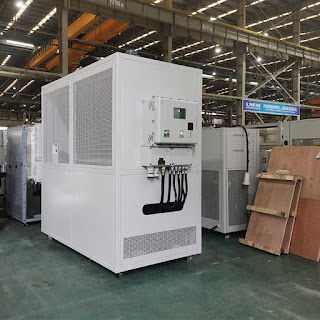The heating circulator is a cooling and heating temperature control device produced by our company that can provide a cold source and a heat source. It has a wide range of applications and can be used in pharmaceutical, chemical, industrial, biological, laboratory and other industries. Dynamic constant temperature control of cold and heat sources.
Heating circulators are suitable for temperature control of glass reactors, metal reactors and bioreactors. Some substances in chemical reactions are exothermic and some are endothermic. The temperature control unit needs to be able to cool and heat over the entire temperature range. In order to ensure the accuracy and stability of temperature control, it is also necessary to dynamically respond to different set target temperatures. Therefore, the requirements for the heating circulator are fast response, fast temperature switching, and fast achievement of the target temperature.
Features of the heating circulator:
1. Heating and electric heating can rapidly increase the temperature of the circulating medium;
2. The PID of the heating circulator is used to control the refrigerant flow and material temperature. The traditional method is to compensate the cooling of the compressor with electric heating;
3. Joint control of heating and cooling to achieve rapid response to heat absorption or heat release of materials;
4. Material temperature control is mainly realized by controlling the refrigerant flow rate, and the refrigerant proportional control valve adopts an electronic expansion valve body. High temperature control accuracy can be achieved;
5. For areas with explosion-proof technical requirements, positive pressure explosion-proof cabinets can be customized, which not only meets the explosion-proof capability requirements of enterprises, but also reduces the number of explosion-proof components and reduces the production and operation costs of the whole machine.
6. The refrigerant or heat medium is transported to the interlayer of supporting facilities and equipment through some built-in circulation pumps and external resource circulation pipelines, which can indirectly cool and heat the material data in the reactor.
7. During external circulation, the upper outlet pipe of the product is connected to the lower water inlet pipe of the kettle body, and the circulating liquid returns from the upper circulation port to the lower return port of the product through various pipes, forming a complete circulation space.
Introduction of heating circulator system:
1. Since the entire liquid circulation of the heating circulator is a closed system, there is no absorption of water vapor at low temperature and no generation of oil mist at high temperature.
2. The heating circulator can realize the continuous rise and fall of the temperature. It adopts high temperature and high pressure operation compressor technology, and can directly start the refrigeration from 200 degrees. The heating circulator can greatly increase the cooling rate, saving test time and energy.
3. Equipped with a heating and cooling integrated container, the heat exchange area is large, the heating and cooling speed is fast, and the demand for heat transfer oil is small.
In the chemical and pharmaceutical field, the necessary temperature control is usually combined with the chemical reaction of the material itself. The temperature of the material can be controlled through the temperature change of the circulating medium in the conduit sleeve or coil, thereby controlling the target process temperature of the material. The heating circulator can control the temperature of related materials, realize the heat absorption of materials or the rapid response to heat release, and meet the production and living needs of the pharmaceutical industry in industrial applications.
OUR WEBSITE: lneya-online.com





No comments:
Post a Comment